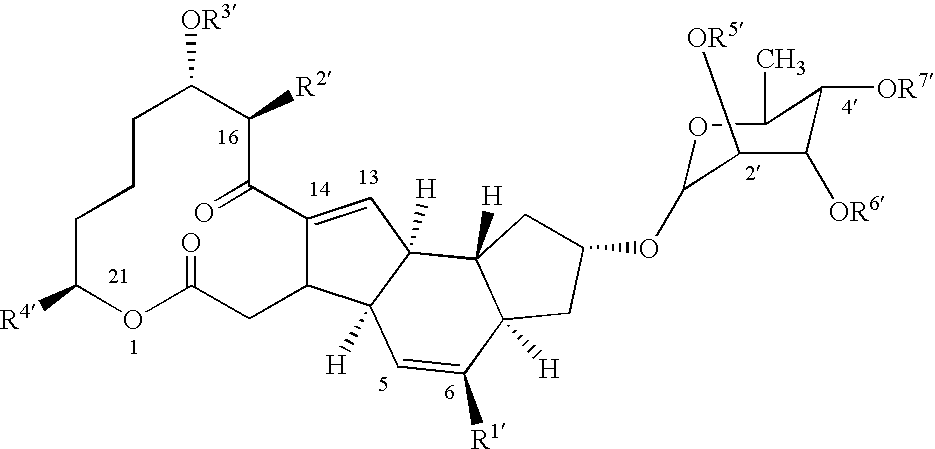DNA encoding SPNF of the spinosyn cluster
a spinosyn and cluster technology, applied in the direction of transferases, bacteria peptides, peptide sources, etc., can solve the problems of large fermentation volume, not controlling all pests, etc., and achieve the effect of altering the spinosyn synthesis
- Summary
- Abstract
- Description
- Claims
- Application Information
AI Technical Summary
Benefits of technology
Problems solved by technology
Method used
Image
Examples
example 1
Improved Yield of Spinosyns A and D by Transformation with Cosmid 9A6
Vegetative cultures of S. spinosa strain NRRL18538 were grown in 50 ml CSM medium (trypticase soy broth 30 g / l, yeast extract 3 g / l, magnesium sulfate 2 g / l, glucose 5 g / l, maltose 4 g / l) in 250 ml Erlenmeyer flasks shaken at 300 rpm at 30° C. for 48 h. Fermentation cultures contained a 1 ml inoculum of this vegetative culture in 7 ml of INF202, a proprietary medium similar to that described in Strobel & Nakatsukasa (1993). The cultures were grown in 30 ml plastic bottles arranged in 10×10 modules, shaken at 300 rpm in a 30° C. room for 3, 5 or 7 days. Broths were extracted with 4 volumes of acetonitrile, then analyzed for spinosyns A+D by isocratic high pressure liquid chromatography (HPLC) through a C-18 reversed-phase column (Strobel and Nakatsukasa, 1993). The amount of spinosyns was determined from absorbance at 250 nm. For each time point, spinosyns A+D were determined from 10 fermentation bott...
example 2
Correction of Methylation Deficiencies in Strain NRRL 18823 by Cosmid 9A6
Although spinosyn synthesis is limited by forosamine supply / addition in strain NRRL 18358, other biosynthetic functions may be limiting in other strains. S. spinosa strain NRRL18823 accumulates spinosyn H (2′-desmethyl-spinosyn A; Kirst et al., 1992), rather than spinosyn A. Spinosyn H is not an intermediate in the spinosyn A biosynthetic pathway, but a "shunt" product synthesized naturally when 2′-O-methylation does not occur. Cosmid 9A6 was conjugated from E. coli strain S17-1 into strain NRRL 18823 using the method described above. Two of the resulting exconjugants, when fermented, produced predominantly spinosyn A, with little spinosyn H (Table 18).
TABLE 18
Strain H (μg / ml) A + D (μg / ml)
NRRL 18823 323 0
NRRL 18823 / 9A6-2 36 551
NRRL 18823 / 9A6-5 45 646
This shows that transformation with Cosmid 9A6 is able to overcome a second type of limitation to spinosyn production—the methylation def...
example 3
Correction of 4′-O-methylation Deficiency in Strain NRRL 18743 by Cosmid 9A6
S. spinosa strain NRRL18743 accumulates spinosyn K (4′-desmethyl-spinosyn A), an intermediate in the spinosyn A biosynthetic pathway. Two of the exconjugants of strain NRRL 18743 containing Cosmid 9A6 produced predominantly spinosyn A, with little spinosyn K, while the third produced no detectable spinosyn K (Table 19).
TABLE 19
Strain K (μg / ml) A + D (μg / ml)
NRRL 18743 488 0
NRRL 18743 / 9A6-1 38 829
NRRL 18743 / 9A6-2 22 725
NRRL 18743 / 9A6-3 0 706
This demonstrates that transformation with Cosmid 9A6 is able to overcome a third type of limitation to spinosyn A production—the methylation deficiency in strain NRRL 18743.
PUM
| Property | Measurement | Unit |
|---|---|---|
| mass | aaaaa | aaaaa |
| mass | aaaaa | aaaaa |
| structures | aaaaa | aaaaa |
Abstract
Description
Claims
Application Information
 Login to View More
Login to View More - R&D
- Intellectual Property
- Life Sciences
- Materials
- Tech Scout
- Unparalleled Data Quality
- Higher Quality Content
- 60% Fewer Hallucinations
Browse by: Latest US Patents, China's latest patents, Technical Efficacy Thesaurus, Application Domain, Technology Topic, Popular Technical Reports.
© 2025 PatSnap. All rights reserved.Legal|Privacy policy|Modern Slavery Act Transparency Statement|Sitemap|About US| Contact US: help@patsnap.com



